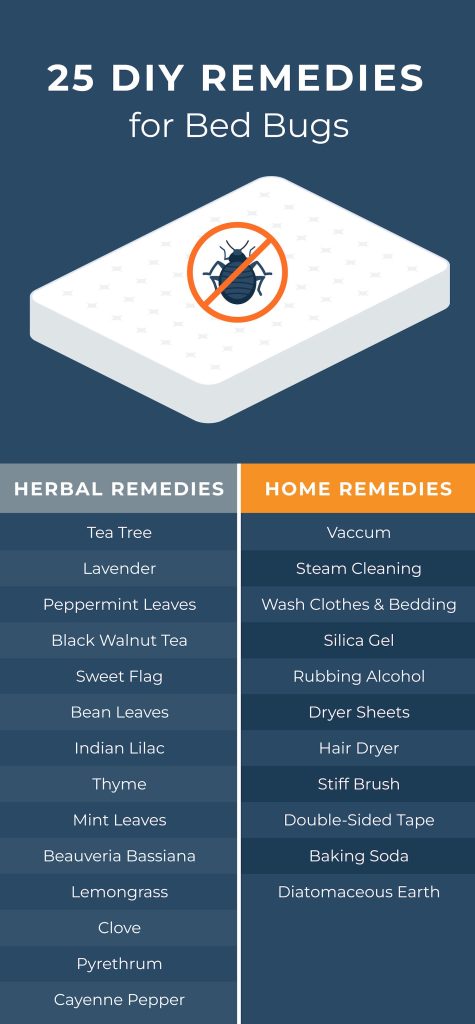Bed bugs are a notorious nuisance, and one of their favorite hiding places is mattresses. Fortunately, we’ve got more than two dozen effective home remedies for your bed bugs so that you can say goodbye to them (hopefully) forever.
Most of our solutions utilize things you’ve already got in the house, but if you do need to go out and purchase something, it should be relatively inexpensive.

What Are Bed Bugs?
Bed bugs are tiny insects that feed on the blood of humans and animals.1 They tend to be active at night, and they’re adept at hiding in dark, soft places and crevices. This makes the mattress an ideal spot for them to settle, hence the name “bed bug.”
They’re hard to spot with the naked eye because they’re so tiny (about the size of a grain of rice), but if you’ve got them wandering around your house and munching on you and your family members, you’ll be sure to know it. Their bites, though harmless, are itchy and uncomfortable.
Where Do Bed Bugs Come From?
Though it seems like they spontaneously appear, bed bugs come bed from outside sources.2 It could mean the literal outdoors, or you may pick them up during travels to hotels, friends’ houses, or even from buying used clothes or furniture.
Another source of an infestation is if a neighbor with a shared wall sets off a bug bomb. These critters are too smart for their own good. When the noxious fumes get released, they seek out a safe haven, and that usually means a neighbor’s house.
These guys have very flattened bodies. That means that they can slip through nearly invisible cracks and crevices.
Learn more bed bug statistics here.
Signs of a Bed Bug Infestation
Bites on Your Skin
The most apparent sign is having bites on your skin. Unlike a flea bite, which is often found around the ankle, the ones from a bed bug can appear anywhere you have exposed skin. This can include places like the neck, arms, shoulders, back, or legs.1
Red/Rusty Stains
Those red- and rusty-looking stains are blood — your blood, to be precise. In this case, it would be blood from your bites, though the stains could also be from the bugs getting squashed at some point.
Black Dots
Everybody poops, including bed bugs. If you see black dots and stains, this is a combination of fecal matter and the skin they shed as the babies become adults. Sounds appetizing, right?
Egg Shells
These are hard to spot because of their small size and light color, but you’ll want to stay on alert for tiny specks of ivory material on your bed, on your furniture, or on the carpet.
Living Bugs
You may even see these guys roaming around from time to time. They’re really tiny, but if you look closely, you may be able to spot them occasionally. After they’ve fed, they’ll be bigger, redder, and easier to see.
Home Remedies for Bed Bugs
Vacuum
Suck those babies up with a strong vacuum cleaner and a powerful hose attachment. You should probably vacuum at least every few days while battling an infestation. Be thorough and use the vacuum on the mattress, bedding, and soft furniture, like sofas and cushy chairs.
Start on elevated surfaces and slowly make your way downward, paying special attention to the carpet, floors, and any cracks in the walls or floorboards. Check electrical appliances like fans and even your laptop for signs of an infestation.
When you’re done vacuuming, discard of the vacuum bag outside, as far away from your home as possible.
Steam Cleaning
For places the vacuum can’t reach, steam cleaning is an option. The heat will kill the bedbugs and eggs, and they will die when exposed to temperatures exceeding 140 degrees Fahrenheit. Follow the steam cleaner’s instructions carefully to avoid damaging your furniture.
Washing All Clothes and Bedding
Check your labels to make sure the fabrics can tolerate hot water and tumble drying. Then wash everything that’s been exposed to these critters. The combination of hot water and dryer heat will help kill off the colony.
Get More Info: How Often Should You Wash Your Sheets?
Silica Gel
The little packets you find in food products and shoe boxes to keep the contents dry could also help kill off insects.3 To use them, grind up the beads and spread the powder around the source areas. If you’ve got kids or pets, you may want to avoid this technique, as direct exposure and silica inhalation are harmful. Instead, opt for baking soda, which has a similar effect.
Rubbing Alcohol
Pour the rubbing alcohol into a spray bottle and spritz away. The alcohol should kill bugs on contact.
Scented Dryer Sheets
The smell from the dryer sheets can repel the insects and even encourage them to seek out other spots to inhabit. However, this solution is likely best used as a temporary one, because they’ll just find a more hospitable place in your home to hang out.
Hair Dryer
If you’re in a hurry to get to sleep and you don’t have days to wait for these other solutions to take effect, blast your hair dryer over the affected areas. The heat will kill the bugs and allow you to go to sleep without having to worry about being someone’s dinner.
Stiff Brush
Run a stiff brush along the mattress seams. This will dislodge any clinging bed bugs and eggs that resist the suction of a vacuum cleaner.
Double-Sided Tape
Wrap the double-sided tape along the circumference of the bedposts along the floor. That way, as bugs try to climb up into bed with you, they’ll get stuck at base camp. Make sure you don’t sabotage your efforts by dragging blankets across the floor. If you neglect to keep blankets, pillows, and clothing off the floor, then don’t be surprised if the more enterprising bugs hitch a ride.
Baking Soda
You may know that baking soda absorbs moisture in the refrigerator, but did you know that it also sucks moisture out of bed bugs’ bodies?4 To use this powder, spread it wherever find bugs, including cracks and crevices. Be sure to vacuum and reapply every few days.
Diatomaceous Earth
This product is a miracle against all types of bugs, including fleas. It’s made from naturally occurring sedimentary rock that’s crumbled into a fine powder. To use it successfully, spread it all over the floor and in cracks and crevices. It can take up to 10 days to work, but the fine powder has tiny shards that kill insects.
We don’t suggest putting it on your mattress, as tempting as it may sound. The reason is that those shards, though microscopic, can get into your lungs and cause damage.
Bed Bug Herbal Remedies
Tea Tree
Tea tree oil is a fresh-smelling essential oil that has antimicrobial properties, so it does double duty as a cleaning agent in your home.5 It kills bacteria and fungi and neutralizes viruses on contact.
It works on these insects by suffocating them as the oil works its way into their system. However, it’s most effective when used undiluted. Unfortunately, an undiluted version isn’t safe for humans. Still, you may see some benefit, or at least a pleasant-smelling home, by spraying diluted tea tree oil around the house. To make the diluted formula, place about 20 drops of oil in a spray bottle filled with water.
Lavender
The smell of lavender makes a bed bug feel nauseous and can even lead to their death. Most humans, however, find the scent quite pleasant. Triple the effectiveness of this solution by washing items with lavender soap, spraying diluted essential oils, and spreading leaves over affected areas.
Peppermint Leaves
Peppermint leaves have the same effect as lavender oil and leaves. Utilize the same strategies and don’t forget to regularly vacuum up old leaves and replace them with fresh versions until the infestation is gone.
Black Walnut Tea
This variety of tea is a natural insect repellent. To employ this strategy, simply take your used tea bags and put them in areas that are infested with bugs. Place them around the house, in every nook, cranny, and corner you can think of.
Sweet Flag
This tall plant found mainly in wetlands is also an effective insect repellent. The herbal version comes in a packet that you can mix into a solution and spray around the house.
Bean Leaves
Bean leaves work kind of like a natural flypaper to trap insects, including bed bugs. Back in 1943, researchers discovered that the microscopic hairs on the leaves worked to both entangle and impale the limbs of these critters.6 Put these leaves on the floor of any room with unwanted inhabitants and prepare to be impressed.
Indian Lilac
The leaves of Indian Lilac have a similar effect to other plant-based, herbal remedies. You can crush the leaves and spread them about. Alternatively, you can boil the leaves, strain the solution, and add it to your bath water. The result is that bed bugs no longer snack on you!
This technique can be used for closet and clothes infestations. Spray the solution in closets, on sofas, and around the home to repel these critters.
Thyme
You might have heard of people burning sage to rid a home of evil spirits, but have you heard of burning thyme to ward off bed bugs?7 It’ll take some time, and the process must be repeated every few days until they’re gone. However, if you tie a stick of thyme with a cloth, and then burn it near infested areas, the bugs will look for friendlier abodes. As always, though, practice fire safety if you use this method.
Mint Leaves
Mint leaves can be a preventive measure. If you place crushed leaves around entry points, it will dissuade them from coming into your home. They’re also safe to use in your closet and directly on your mattress.
Beauveria Bassiana
Don’t be alarmed by the description, but Beauveria bassiana is a parasitic fungus that feeds on insects.8 This fungus ruthlessly attacks bed bugs, rendering them infertile, immobile, and unable to feed.
Lemongrass
Unlike some of the other natural solutions that only repel the insects, lemongrass can kill them. The acid levels kill the bugs and their eggs. Plus, they hate the smell, so it does also serve as a repellent.
Clove
Cloves act much in the same way as lemongrass. If you’re not a fan of how lemongrass smells, opt for cloves and clove oil instead. You can even put clove oil on mattresses and pillows to ward these critters off.
Pyrethrum
This extract is derived from chrysanthemums. The chrysanthemum, also called a mum, is a bright flower that can be found in a variety of colors. It also works as a natural killer by attacking the nervous system.
Cayenne Pepper
When mixed with other natural items like ginger and oregano, cayenne pepper works to kill a bed bug on contact. Here’s how to make this natural solution:
- Mix one teaspoon each of cayenne pepper, ground ginger, and oregano oil.
- Strain the ingredients and add them to a spray bottle filled with water.
- Spray to your heart’s content.
Are Bed Bugs Harmful to Your Health? Dr. Raj Explains

Bed Bug FAQs
Do home remedies for bed bugs work?
According to the Environmental Protection Agency (EPA), some at-home, non-chemical bed bug treatments do work.9 For example, some hot and cold treatments and certain steam cleaners have been shown to work on treating bed bugs. Additionally, DIY interceptor traps seem to be effective at preventing bed bugs from climbing the legs of furniture.
Your success at treating bed bugs on your own will likely depend on how many bed bugs you have, how much clutter or furniture you have, whether your neighbors also have bed bugs, and whether or not all residents are willing to treat the problem at the same time.9
What home remedy will kill bed bugs fast?
Steam cleaning is an effective way to kill bed bugs fast.10 The steam cleaner’s temperature will need to be at least 130 degrees, and it should not have a forceful airflow for this to be most effective.9
What is a home remedy for bed bug bites?
Luckily, bed bug bites don’t usually need treatment and should disappear on their own within one or two weeks.11 If they’re really bothering you, though, you can use some over-the-counter hydrocortisone cream or an antihistamine to reduce itchiness.
Oatmeal baths can also be used to reduce itchiness. Colloidal (or ground) oats are especially effective at treating itching skin.12
My Final Word of Advice
Now that you’re equipped with numerous options to help get rid of bed bugs, you can pick what solution works best for you. These DIY bed bug remedies can not only help you feel better about where you sleep but also leave your mattress in better condition.
Looking to upgrade your mattress? Explore our picks for the best mattresses of 2024.

Julia Forbes
Mattress Tester
About Author
Julia is a product tester at Sleep Advisor, specializing in testing out mattresses and sleep accessories – she’s in the right line of work, because she loves to sleep.
Stomach Sleeper
Education & Credentials
- Certified Sleep Science Coach
References:
- Potter, Michael F. “Bed Bugs”. University of Kentucky. Last modified July 2020.
- “Bed Bugs – What They Are and How to Control Them”. New York State Department of Health. Last modified May 2021.
- Lavon, Ophir., Bentur, Yedidia. “Silica Gel: Non-Toxic Ingestion with Epidemiologic and Economic Implications”. National Library of Medicine. 2015.
- Lindquist, Shannon. “Endless uses of baking soda”. Michigan State University. 2013.
- “Tea Tree Oil”. National Center for Complementary and Integrative Health. Last modified October 2020.
- Nuwer, Rachel. “Bean Leaves Don’t Let the Bedbugs Bite by Using Tiny, Impaling Spikes”. Smithsonian Magazine. 2013.
- Rindels, Sherry. “All We Have is Thyme”. Iowa State University. 1997.
- Ortiz-Urquiza, Almudena. “The Split Personality of Beauveria bassiana: Understanding the Molecular Basis of Fungal Parasitism and Mutualism”. ASM Journals. 2021.
- “Do-it-yourself Bed Bug Control”. United States Environmental Protection Agency. Last modified May 31, 2023.
- Miller, Dini M. “Using Heat to Kill Bed Bugs”. Virginia Tech. Webpage accessed March 26, 2023.
- “Bedbugs”. Mayo Clinic. Last modified January 5, 2024.
- Ilnytska, Olha., et. al. “Colloidal Oatmeal (Avena Sativa) Improves Skin Barrier Through Multi-Therapy Activity”. Johnson & Johnson Skin Research Center. 2016.
